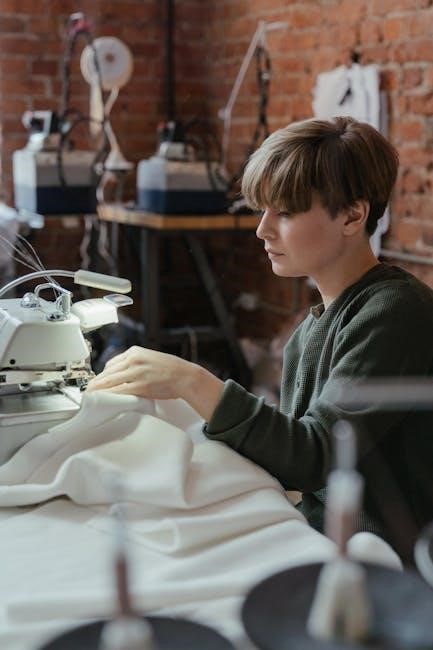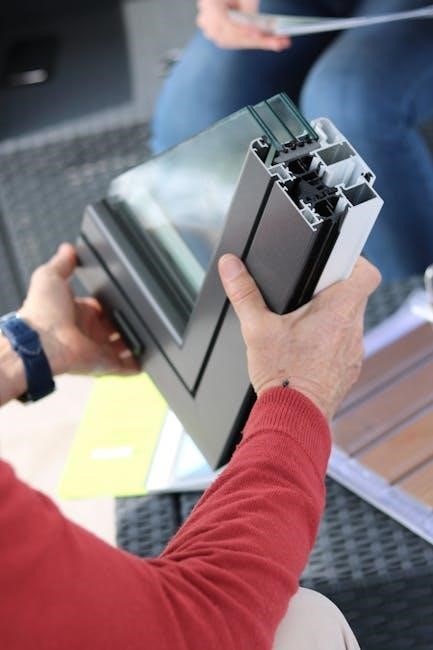Welcome to the Kenmore Mini Ultra Sewing Machine Manual! This guide provides essential instructions for operating and maintaining your compact sewing machine effectively․ Discover its features, including threading, bobbin winding, and decorative stitches, while ensuring safety and optimal performance with detailed care tips․
Overview of the Kenmore Mini Ultra Sewing Machine
The Kenmore Mini Ultra Sewing Machine is a compact and portable sewing machine designed for versatility and ease of use․ It features a durable construction and user-friendly interface, making it suitable for both beginners and experienced sewists․ This machine is ideal for a variety of sewing tasks, from basic repairs to creative projects․ Its compact size allows for easy storage and transportation, while its robust design ensures consistent performance․ The Mini Ultra Sewing Machine is equipped with essential features such as adjustable stitch length and width, providing flexibility for different fabrics and techniques․ Whether you’re working on home decor, clothing, or crafts, this machine offers the perfect blend of functionality and portability․ Its lightweight design and intuitive controls make it a valuable addition to any sewing workspace․
Importance of the Manual for Proper Usage
The Kenmore Mini Ultra Sewing Machine Manual is essential for ensuring safe, effective, and efficient operation of the machine․ It provides detailed instructions on setting up the machine, threading, and bobbin winding, which are critical for proper functionality․ The manual also outlines safety precautions to prevent accidents and damage to the machine․ By following the guidelines, users can optimize their sewing experience and achieve professional results․ Additionally, the manual includes troubleshooting tips to resolve common issues, such as thread tension problems or jammed stitches․ Whether you’re a beginner or an experienced sewist, the manual serves as a comprehensive guide to unlocking the machine’s full potential․ Regularly referring to the manual helps maintain the machine’s performance and extends its lifespan, ensuring years of reliable service․
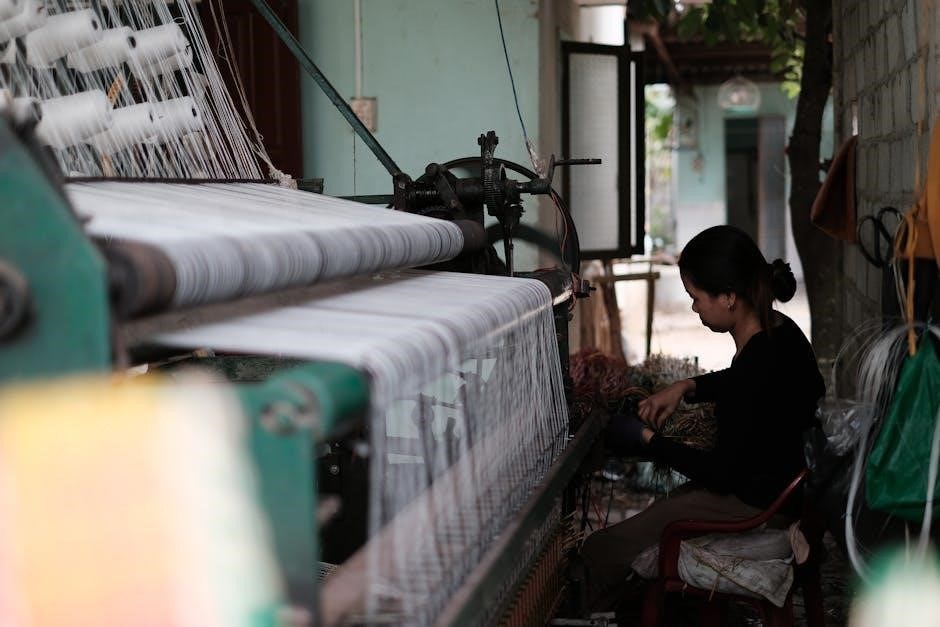
Getting Started with the Kenmore Mini Ultra Sewing Machine
Start your journey with the Kenmore Mini Ultra Sewing Machine by following the manual’s initial setup guide․ Properly thread the machine, wind the bobbin, and install the needle․ These steps ensure smooth and efficient sewing․
Threading the Machine
Threading the Kenmore Mini Ultra Sewing Machine is a straightforward process when done correctly․ Begin by locating the thread guide on the machine, which helps direct the thread smoothly․ Gently pull the thread from the spool and pass it through the guide, ensuring it is not twisted․ Next, bring the thread down to the take-up lever, which regulates thread tension․ Loop the thread around the lever and pull it gently to seat it properly․ Continue by guiding the thread through the needle’s eye, leaving a small tail․ Finally, pull the thread to ensure it is secure and evenly tensioned․ Proper threading is essential for consistent stitching and preventing machine jams․ Always refer to the manual for specific diagrams and step-by-step guidance to ensure accuracy․
Bobbin Winding and Installation
Winding and installing the bobbin correctly is crucial for smooth operation of the Kenmore Mini Ultra Sewing Machine․ Start by pulling the handwheel out to disengage the machine’s mechanism․ Place the bobbin on the winder and draw thread from the spool, securing it through the bobbin’s hole․ Wind the thread evenly, ensuring it does not overlap or twist․ Once full, cut the thread and remove the bobbin․ To install, insert the bobbin into the bobbin case, making sure it spins counterclockwise when gently tugged․ Pull the thread through the slot in the case and close it securely․ Properly wound and installed bobbins prevent uneven stitching and machine jams․ Always refer to the manual for specific diagrams and instructions to ensure accurate bobbin preparation and installation․
Key Features of the Kenmore Mini Ultra Sewing Machine
The Kenmore Mini Ultra Sewing Machine features an ultra-stitch setting for consistent stitching, zigzag and decorative stitch options, and a sew-by-color function for personalized sewing projects․
Ultra-Stitch Feature for Uniform Stitches
The Ultra-Stitch feature on the Kenmore Mini Ultra Sewing Machine ensures consistent and uniform stitches, making it ideal for both beginners and experienced sewists․ This feature automatically adjusts stitch length and tension, providing professional-looking results on various fabrics․ With the Ultra-Stitch setting, you can achieve perfectly aligned seams and even stitching, which is especially useful for delicate materials like silk or chiffon․ The feature also enhances the durability of your stitches, reducing the risk of loose threads or uneven fabric edges․ By utilizing the Ultra-Stitch option, you can focus on creativity while the machine handles the technical aspects, delivering flawless stitching every time․ This feature is a standout element that sets the Kenmore Mini Ultra apart from other compact sewing machines․
Zigzag and Decorative Stitch Options
The Kenmore Mini Ultra Sewing Machine offers a variety of zigzag and decorative stitch options, allowing you to add creativity to your projects․ These stitches are perfect for embellishing fabrics, creating borders, or adding texture to garments․ With the zigzag stitch, you can easily sew stretchy fabrics or prevent fraying on raw edges; The decorative stitches, including patterns like scallops and flowers, enable you to personalize your sewing projects with elegance․ The machine’s intuitive controls make it easy to select and adjust stitch width and length, ensuring precise results․ Whether you’re crafting home decor, clothing, or accessories, the zigzag and decorative stitches provide versatility and flair, making your sewing experience both fun and rewarding․ This feature is especially useful for crafting unique designs and adding a personal touch to your creations;
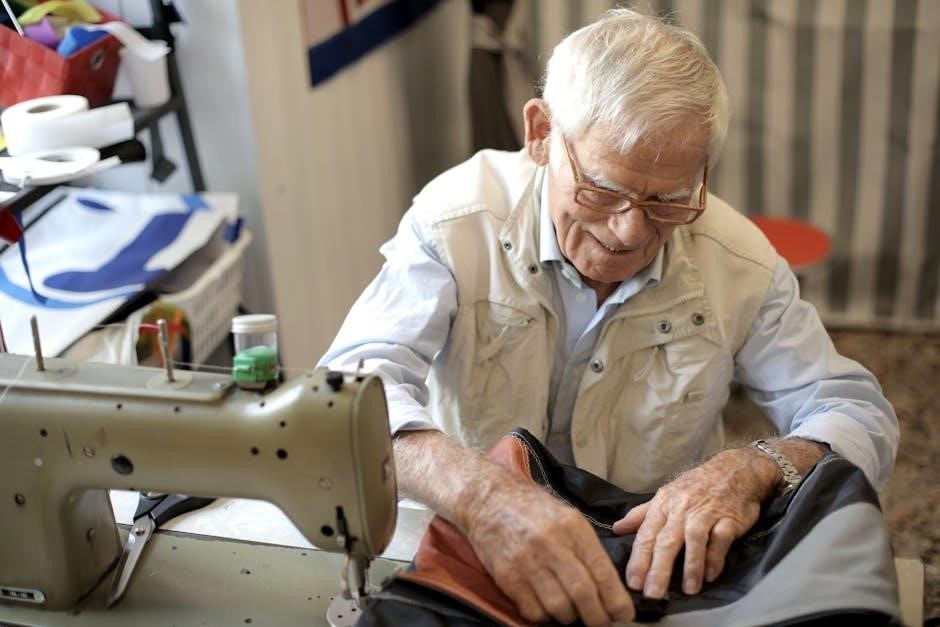
Basic Operations and Settings
Master the fundamentals of sewing with the Kenmore Mini Ultra․ Learn to thread the machine, wind bobbins, and adjust tension for smooth stitching․ These settings ensure precise control and professional results․
Adjusting Thread Tension
Proper thread tension is crucial for achieving consistent stitches on the Kenmore Mini Ultra Sewing Machine․ To adjust the tension, start by locating the small dial or knob on the machine’s front or side, depending on the model․ Gently turn the dial clockwise to increase tension or counterclockwise to decrease it․ Always test the tension by sewing a small sample to ensure the stitches are balanced and even․ It’s important to reference the manual for specific guidance, as incorrect tension can lead to issues like puckering fabric or loose stitches․ Keep the machine clean and well-lubricated to maintain optimal performance․
Using the Sew-by-Color Feature
The Sew-by-Color feature on the Kenmore Mini Ultra Sewing Machine allows for easy stitch selection based on color-coded settings․ To use this feature, locate the color-coded stitch chart on the machine or in the manual․ Simply select the desired stitch by matching the color to the corresponding dial or button․ This feature ensures uniform stitching and simplifies the process of choosing the right stitch for your fabric type․ Always refer to the manual for specific guidance, as the exact steps may vary slightly depending on the model․ Regularly cleaning and maintaining the machine will help ensure the Sew-by-Color feature operates smoothly․ This innovative tool is designed to enhance your sewing experience, making it easier to achieve professional-looking results․
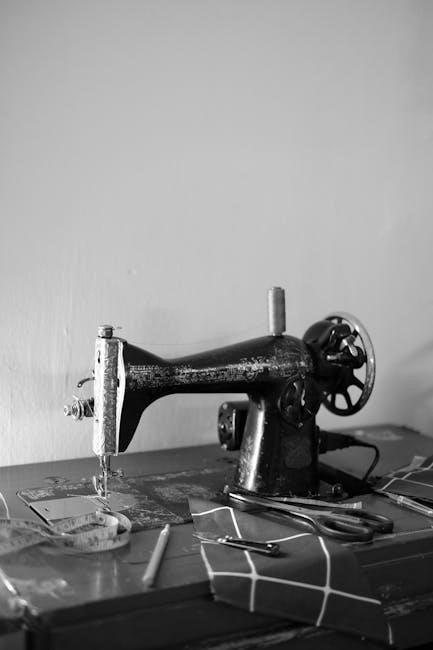
Maintenance and Care
Regular maintenance ensures your Kenmore Mini Ultra Sewing Machine performs optimally․ Clean the machine after use, oil moving parts, and check for wear․ Follow manual guidelines for longevity․
Cleaning the Machine
Regular cleaning is crucial to maintain the performance of your Kenmore Mini Ultra Sewing Machine․ Turn off and unplug the machine before starting․ Remove any lint or debris from the bobbin area using a lint brush or a small cloth․ Gently wipe the exterior with a soft, dry cloth to remove dust and stains․ Avoid using liquids or harsh chemicals, as they may damage the finish․ For tough lint buildup, use compressed air carefully․ Clean the needle area and presser foot regularly to ensure smooth operation․ Always refer to the manual for specific cleaning instructions tailored to your machine․ Regular maintenance prevents dust and lint from affecting stitching quality and keeps your machine running efficiently for years․
Lubricating Moving Parts
Lubricating moving parts is essential for maintaining the Kenmore Mini Ultra Sewing Machine’s performance․ Regularly apply a few drops of sewing machine oil to the gears and bearings to ensure smooth operation․ Avoid over-lubrication to prevent dust buildup․ After applying, gently wipe any excess oil with a clean cloth․ Check the manual for specific lubrication points and follow the recommended schedule to keep your machine running efficiently․
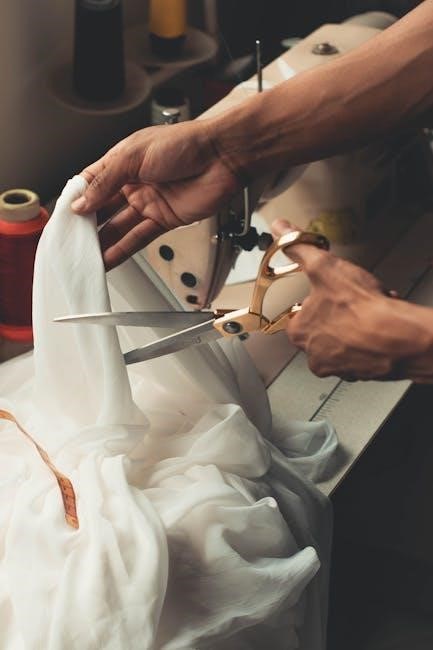
Troubleshooting Common Issues
Common issues like thread jams or uneven stitches can be resolved by checking tension settings and ensuring proper threading․ Refer to the manual for detailed troubleshooting steps․
Resolving Tension Problems
Tension issues are common but easily fixable․ Start by checking the upper thread path, ensuring it’s properly threaded through all guides․ Next, inspect the bobbin area for correct installation and thread flow․ If stitches are uneven, adjust the tension dials on the machine, referring to the manual for specific settings․ Test the stitch quality on a scrap fabric after each adjustment․ For persistent problems, clean the tension discs and rethread the machine․ Proper tension ensures uniform stitches and prevents thread breakage; Always refer to the manual for detailed guidance on tension adjustment to maintain optimal sewing performance and extend the machine’s lifespan․
Fixing Jammed Stitches
If your Kenmore Mini Ultra Sewing Machine experiences jammed stitches, start by turning it off and unplugging it for safety․ Gently cut the excess thread and remove any tangled fabric․ Check the needle for damage or improper installation—replace it if necessary․ Inspect the bobbin area for thread tangles or debris, and clean it thoroughly․ Re-thread the machine, ensuring the thread follows the correct path․ If the issue persists, check the bobbin for proper winding and installation․ Avoid pulling fabric forcefully, as this can cause further jams․ Regularly cleaning the machine and using the correct needle size for your fabric type can prevent stitch jams․ Always refer to the manual for specific troubleshooting steps to restore smooth stitching performance and maintain your machine’s efficiency․
